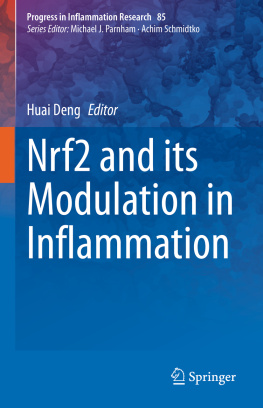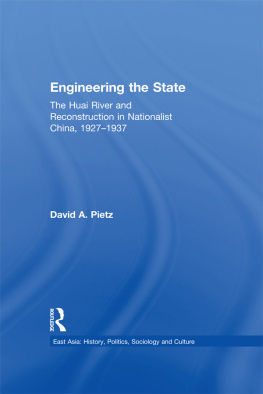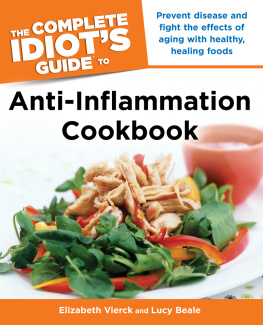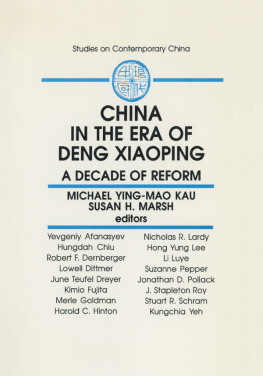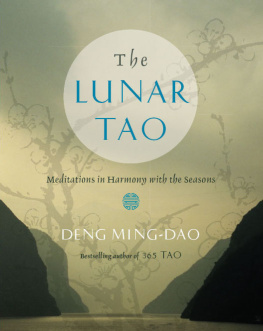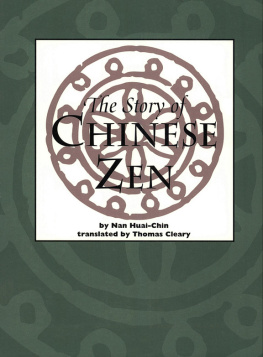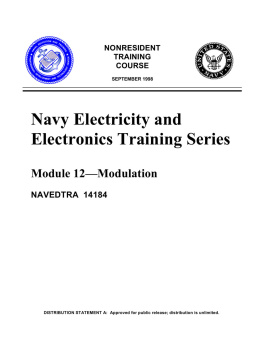Huai Deng - Nrf2 and its Modulation in Inflammation
Here you can read online Huai Deng - Nrf2 and its Modulation in Inflammation full text of the book (entire story) in english for free. Download pdf and epub, get meaning, cover and reviews about this ebook. year: 2020, publisher: Springer International Publishing, genre: Romance novel. Description of the work, (preface) as well as reviews are available. Best literature library LitArk.com created for fans of good reading and offers a wide selection of genres:
Romance novel
Science fiction
Adventure
Detective
Science
History
Home and family
Prose
Art
Politics
Computer
Non-fiction
Religion
Business
Children
Humor
Choose a favorite category and find really read worthwhile books. Enjoy immersion in the world of imagination, feel the emotions of the characters or learn something new for yourself, make an fascinating discovery.
- Book:Nrf2 and its Modulation in Inflammation
- Author:
- Publisher:Springer International Publishing
- Genre:
- Year:2020
- Rating:5 / 5
- Favourites:Add to favourites
- Your mark:
- 100
- 1
- 2
- 3
- 4
- 5
Nrf2 and its Modulation in Inflammation: summary, description and annotation
We offer to read an annotation, description, summary or preface (depends on what the author of the book "Nrf2 and its Modulation in Inflammation" wrote himself). If you haven't found the necessary information about the book — write in the comments, we will try to find it.
Nrf2 and its Modulation in Inflammation — read online for free the complete book (whole text) full work
Below is the text of the book, divided by pages. System saving the place of the last page read, allows you to conveniently read the book "Nrf2 and its Modulation in Inflammation" online for free, without having to search again every time where you left off. Put a bookmark, and you can go to the page where you finished reading at any time.
Font size:
Interval:
Bookmark:
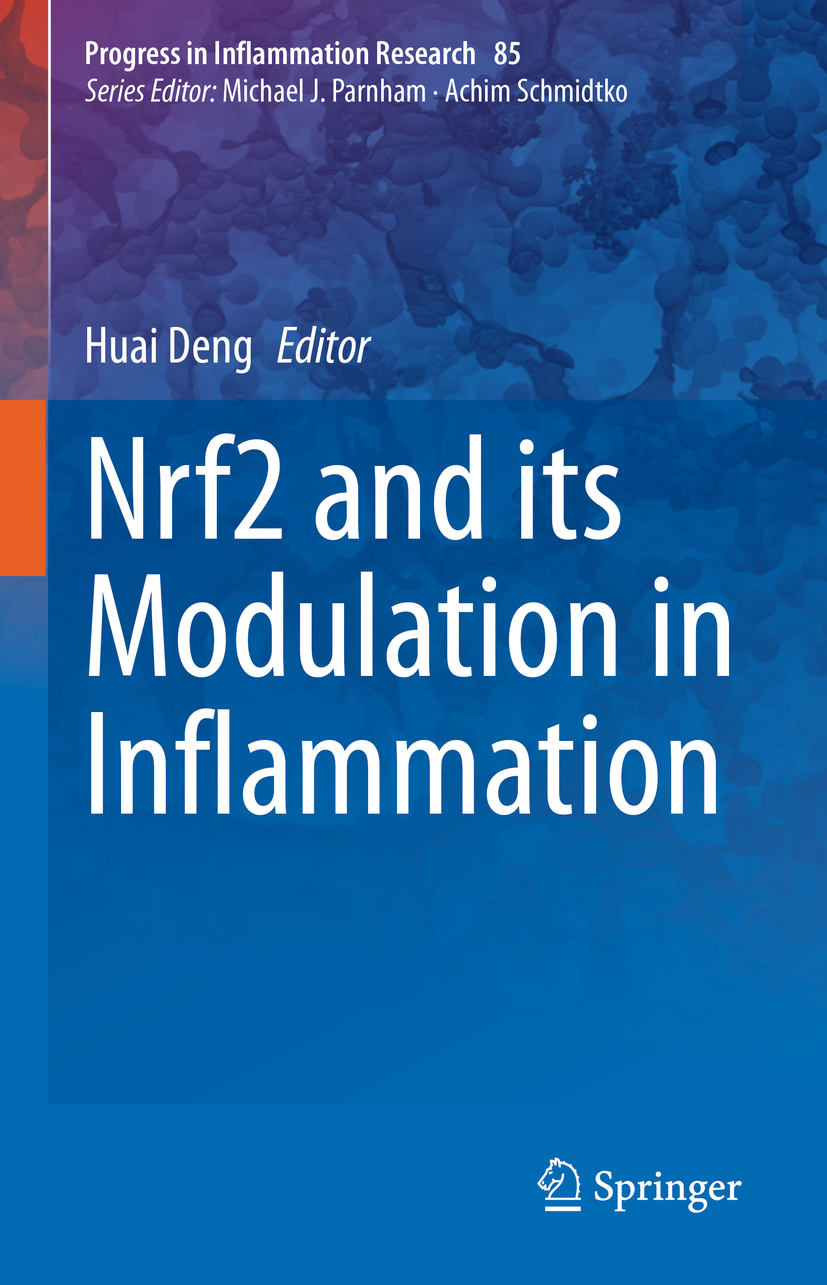
The last few years have seen a revolution in our understanding of how blood and tissue cells interact and of the intracellular mechanisms controlling their activation. This has not only provided multiple targets for potential anti-inflammatory and immunomodulatory therapy, but has also revealed the underlying inflammatory pathology of many diseases.
This series provides up-to-date information on the latest developments in the pathology, mechanisms and therapy of inflammatory disease. Areas covered include: vascular responses, skin inflammation, pain, neuroinflammation, arthritis cartilage and bone, airways inflammation and asthma, allergy, cytokines and inflammatory mediators, cell signalling, and recent advances in drug therapy.
Each volume is edited by acknowledged experts providing succinct overviews on specific topics intended to inform and explain. The series is of interest to academic and industrial biomedical researchers, drug development personnel and rheumatologists, allergists, pathologists, dermatologists and other clinicians requiring regular scientific updates.
More information about this series at http://www.springer.com/series/4983

This Springer imprint is published by the registered company Springer Nature Switzerland AG
The registered company address is: Gewerbestrasse 11, 6330 Cham, Switzerland
Environmental toxins generated by modern industry significantly influence human health. Many of these toxins, when entering cells, can damage macromolecules including DNA, proteins, and lipids, either directly by themselves or indirectly via producing reactive oxidative species (ROS). Excess ROS levels can also be caused by dysfunctions of intracellular programs. It is believed that the oxidative and xenobiotic stimuli in different tissues account for the pathogeneses of many human diseases. Cellular factors that can respond to and eliminate oxidative and xenobiotic stresses are essential protective machineries against the environment toxin-induced pathogeneses.
Inflammation is a combinatory process that protects cells against the injuries caused by physical damage, bacterial/viral infections, or chemical toxins. This process includes recruitment of immune cells and release of molecular mediators such as cytokines. Unlike acute inflammation as a short-term natural healing process, chronic inflammation lasts for months or years and results in many diseases, including cardiovascular dysfunctions, metabolic syndrome and diabetes, neurodegeneration, cancer, and respiratory diseases. One mechanism whereby chronic inflammation leads to these pathologies is the enhanced ROS levels caused by the recruited mononuclear immune cells such as macrophages, neutrophils, and lymphocytes at the injured tissue. Chronic inflammation can also be directly induced by prolonged exposure to some environmental toxins. Therefore, oxidative and xenobiotic response pathways are important anti-inflammation mechanisms.
The NF-E2-related factor 2 (Nrf2) transcription factor is a central regulator that mediates transcriptional responses to oxidative and xenobiotic stimuli. Nrf2 can bind to antioxidant response elements (AREs), and it activates a battery of antioxidant and detoxifying genes. Most of the Nrf2-target genes code for enzymes that catalyze the metabolism or removal of ROS and other toxins. These include phase I enzymes (e.g., SOD, GPx), phase II enzymes (e.g., GST, NQO1), phase III transporters (e.g., MRP1), and other antioxidant proteins such as HO-1. The key regulator for Nrf2 activity in response to oxidative/xenobiotic stresses is kelch-like ECH-associated protein 1 (Keap1). Keap1 interacts with Nrf2 and induces its ubiquitination and degradation in the cytoplasm. According to the conventional models, modification of cysteines on Keap1 by oxidative and xenobiotic compounds interferes with the Keap1Nrf2 interaction and blocks Nrf2 degradation, which leads to nuclear accumulation of Nrf2 and activation of Nrf2-target genes.
Dysfunctions of Nrf2 and/or Keap1 were found to be related to many human diseases as well as inflammation. It is generally accepted that these pathogeneses are mediated by an imbalance redox hemostasis that are caused by the defected Keap1-Nrf2 pathway. However, the pathological roles of Nrf2 are complicated and sometimes paradoxical. For example, Nrf2 can both prevent and promote oncogenesis. Several models state that the levels of Nrf2 are critical for the distinct functions of Nrf2 in different aspects. Studies in the last 20 years have revealed a number of novel Nrf2-target genes and functions that are independent of redox regulation and detoxification, illuminating that Nrf2 can act more than a detoxifying factor. Studies in different model systems have identified the novel functions of Nrf2 in developmental programs, including cell proliferation, stem cell self-renewal and differentiation, apoptosis, autophage, lipid metabolism and adipogenesis, glucose metabolism, steroid hormone synthesis and responses, etc. It is likely that Nrf2 activates antioxidant and detoxifying genes in an inducible and global manner, and at the same time regulating developmental genes in a basal and tissue-specific manner.
Nrf2 also interacts with many other proteins and pathways, placing Nrf2 in a multi-layer network that regulates redox homeostasis as well as other cellular programs. The proteins that can directly interact with Nrf2 include small Mafs, NF-B, AP-1, CBP/p300, MED16, CFTR, ATF3, ATF4, Bach1, ER, PPAR, RAR, p62, ARF, Brg1, CHD6, SMRT, p21, DJ-1, and PGAM5. These proteins can activate or suppress the Nrf2-mediated transcription through mechanisms such as dimerizing with Nrf2 at ARE or competing Nrf2 interaction with other proteins. Nrf2 can also be covalently modified by phosphorylation and acetylation, which could regulate Nrf2 stability, localization, and activity. In recent years, epigenetic functions of Nrf2 have been noticed. Nrf2 is able to interact with chromatin modifiers including ATP-dependent chromatin remodeling complexes, HATs, and HDACs. Cooperative roles of Nrf2 and some of its interacting proteins have been identified in a number of pathogeneses. Taken together, it is believed that the multiple interacting partners and biological functions of Nrf2 to some extent account for the complicated roles of Nrf2 in different diseases.
Font size:
Interval:
Bookmark:
Similar books «Nrf2 and its Modulation in Inflammation»
Look at similar books to Nrf2 and its Modulation in Inflammation. We have selected literature similar in name and meaning in the hope of providing readers with more options to find new, interesting, not yet read works.
Discussion, reviews of the book Nrf2 and its Modulation in Inflammation and just readers' own opinions. Leave your comments, write what you think about the work, its meaning or the main characters. Specify what exactly you liked and what you didn't like, and why you think so.

